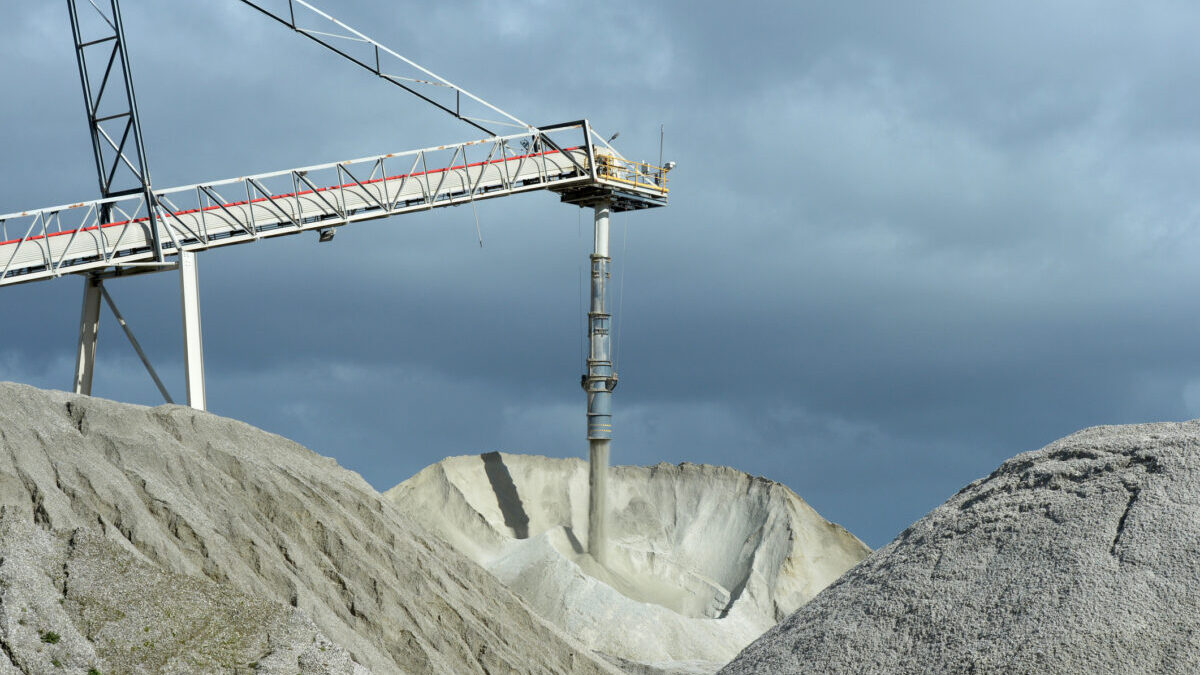Ground Breakers: MinRes boss lets loose on downstream lithium plans, goldies Red 5, Westgold, Perseus reporting

Pic: Carla Gottgens/Bloomberg via Getty Images
- MinRes boss Chris Ellison looking to sell lithium salts direct to OEMs in US and Europe after nixing China deal
- Perseus continues to stand out as it exceeds 2023 gold guidance
- Westgold and Red 5 deliver solid June quarters
Mineral Resources (ASX:MIN) is targeting the European and US market in its downstream lithium ambitions, planning to sell an intermediary sulphate to the West after repudiating a deal to share in Albemarle’s processing plants in China.
The company surprised investors last week by restructuring its lithium JV with Albemarle for the umpteenth time, selling its 15% stake in the Kemerton hydroxide plant in WA and ending an arrangement to take on 50% of two plants with a 100,000tpa hydroxide processing capacity in the Middle Kingdom.
But MinRes head honcho Chris Ellison, who has targeted incentives and financial support from the Federal Government to build downstream lithium processing capacity in Australia, has signalled his intent to supply the US and Europe directly as OEMs build electric vehicle production onshore.
“We don’t exactly want to build hydroxide here. That is difficult and it’s expensive,” he said in a firey quarterly call that included a number of broadsides at analysts with bearish outlooks on lithium and the company.
“But we can take our spodumene out to sulphate at 25-30% where we can get rid of a lot of the bulk.
“And our intention is we’re going to send that directly into Europe and the US, we’re well advanced on discussions around that and we want to have long term contracts directly with the OEMs.
“And we’re advanced on those discussions. So I mean, basically I think the world’s waking up that if you want surety of supply, if you’re going to go and spend billions and billions of dollars on assembly lines to build cars, you’ve got to be able to go and have a deal direct with the owners of the rock.”
Ellison was at pains to say the partnership with Albemarle remained positive. The two own the Wodgina mine in the Pilbara 50-50 with MinRes to operate the project and take full control of its share of offtake as part of the restructure.
“The partnership with Albemarle is incredibly strong and right now, I mean, they are screaming for rock in China so there’s no push back on us,” Ellison said.
“It’s simply we’ve got to get at what brought those plants online quickly and we’ve got to get at the ore body but Albemarle need more rock in China.
“So I read a comment this morning that there was some potential that Albemarle is pushing back and not taking Wodgina volumes to process into chemicals … Horses..t.”
Why has MinRes turned its back on China?
China, on the face of it, is the best place in the world to build a lithium hydroxide plant. There they emerge in months off a virtual production line, ready to supply battery grade chemicals for the world’s largest EV market.
But there are complexities to doing business in China that make the roughly $1 billion investment MinRes had planned there a non-starter.
“So these plants are going to be running for 40-50 years plus so you go into China, you got like 13% VAT on your spot, you’ve got to make a minimum profit over there,” Ellison said.
“If you sell your hydroxide in China, you pay the Chinese tax obviously, but then your money is caught there for a year and when you bring it out, if you bring it from China direct to Australia, there’s another 10% withholding tax that disappears.
“And if you send your hydroxide out of China and sell it here, there’s another 14.5% VAT, add all that up and you’ve got to operate so that’s half the reason we’re not going to be in China.”
Australia, on the other hand, is predictable and produces material that will be sought-after for strategic and ethical reasons by carmakers hoping to pull in incentives from the USA’s Inflation Reduction Act and similar policies in Europe.
“If I operate here in Australia we know what the taxes are. We know what the quality of the workforce (is) we’ve got here,” Ellison said.
“That’s where we’re going to be and we’re going to partner up with Europe and North America, it’s so much more economic for us.
“Stability going forward. I mean, anyone out there right now that wants to buy hydroxide, they want it to come from Australia, that’s their first choice in the world, because it’s ethical and they know that environmentally and the way we look after our people we do it right.
“So we’re a sought-after product. And we want to keep that sanitised if we can.”
Now for the numbers
MinRes produced 234,000t of spodumene from its half share of the Mt Marion lithium mine in FY23, including 60,000t in the June quarter, with costs expected to fall within its $1200-1250/t guidance range.
Co-owned by Ganfeng, who MinRes has ended a toll treating agreement with for its Mt Marion con, the mine pulled in average realised spodumene concentrate prices of US$2589/dmt, down 23% QoQ including grade adjustments and product downgrades.
At Wodgina it produced 148,000t on a 40% basis (the 50-50 arrangement with Albemarle is yet to kick in), up 1746% YoY, including 41,000t in the June quarter.
From that it produced and sold 11,497t and 7286t respectively of battery chemicals toll treated in China. 3500t of lithium chemicals were sold at an average price of US$40,484/t in June, down 46% QoQ, with full year sales in line with guidance.
On an SC6 basis, the price applied to Wodgina shipments was US$3739/t.
Across its longer running iron ore business, MinRes shipped 7.65Mt from its Yilgarn iron ore hub and 9.84Mt from its Utah Point hub for 17.5Mwmt, within its 17.2-18.8Mwmt guidance range, with FOB costs in the upper end of its FY23 guidance range of $73-83/t.
It pulled in US$91/dmt in the June quarter, down 16% QoQ at an 82% realisation to the Platts 62% IODEX.
In a major step change for MinRes’ iron ore business, it plans to ship first ore from its 35Mtpa Onslow iron ore hub by June next year after getting all its major approvals for the mine.
Mineral Resources (ASX:MIN) share price today:
Perseus beats guidance to lead gold reports
West African gold producer Perseus Mining (ASX:PRU) continues to stand out among a gold crowd who tend to disappoint you more than your pie-chucking children at a game of under-8s cricket.
Not so Perseus, unless you include what appears at the moment to be an ill-fated and wasteful move into Sudan.
The miner produced 136,634oz at an all in site cost of US$1007/oz with a cash margin of US$926/oz, with gold sales of 140,533/oz.
At 266,909oz in the June half at US$989/oz and 535,281oz at US$959/oz for the financial year, Perseus said both “significantly outperformed market production and cost guidance”.
That’s not a phrase you hear often these days. By contrast, PRU delivered 494,014oz in FY22 at US$952/oz.
Perseus has US$522m in its bank account with no debt, and saw US$51m added to its cash and bullion balance in the June quarter, with its cash margin 9% higher QoQ on higher gold prices of US$1933/oz (up 6% or US$112/oz).
On the downside, PRU has had to suspend an FID and pre-development works on the Meyas Sand project in northern Sudan due to security concerns, with the country currently embroiled in a civil conflict which has killed thousands and displaced millions.
Perseus paid C$17 million cash and C$198m in shares to pick up the Meyas Sand project in a takeover of Canada’s Orca Gold in early 2022.
While Perseus is a regular performer, Red 5 (ASX:RED) shares were up as it finally began to demonstrate the potential of its King of the Hills mine in the Leonora gold district.
Red 5 has set FY24 guidance of 195,000-215,000oz at AISC of $1850-2100/oz after producing a strong quarter in June of 61,705oz at $1690/oz.
That was a big improvement on 40,869oz in the March quarter, delivered second half within guidance at 102,574oz at $1837/oz.
RED had $45.9m in cash at June 30 and repaid $22m of bank debt in the quarter, with $127.8m outstanding on its debt facility and its net debt position falling $44.5m to $81.9m.
Up 2.2% this morning was Westgold Resources (ASX:WGX), which doubled its operating cash flow to $64m in the June quarter on a 13% increase in production and 15% drop in AISC to 68,377oz at $1780/oz.
That saw FY23 production come in, as previously announced, at the top end of guidance at 257,116oz and costs at the mid-point at $1999/oz. That was partly assisted by outperformance at the Big Bell mine, which delivered 26,000oz at mine grades of 2.8g/t.
Its reserve grade is expected to fall back to reserve grade levels in the coming quarters. The Starlight mine also delivered a 32% increase in mine ounces at 163,000t at 2.5g/t for 12,900oz.
READ: Davids and Goliaths: Is this the year the gold sector’s mid-tier wins?
Gold reports share prices today:

UNLOCK INSIGHTS
Discover the untold stories of emerging ASX stocks.
Daily news and expert analysis, it's free to subscribe.
By proceeding, you confirm you understand that we handle personal information in accordance with our Privacy Policy.








